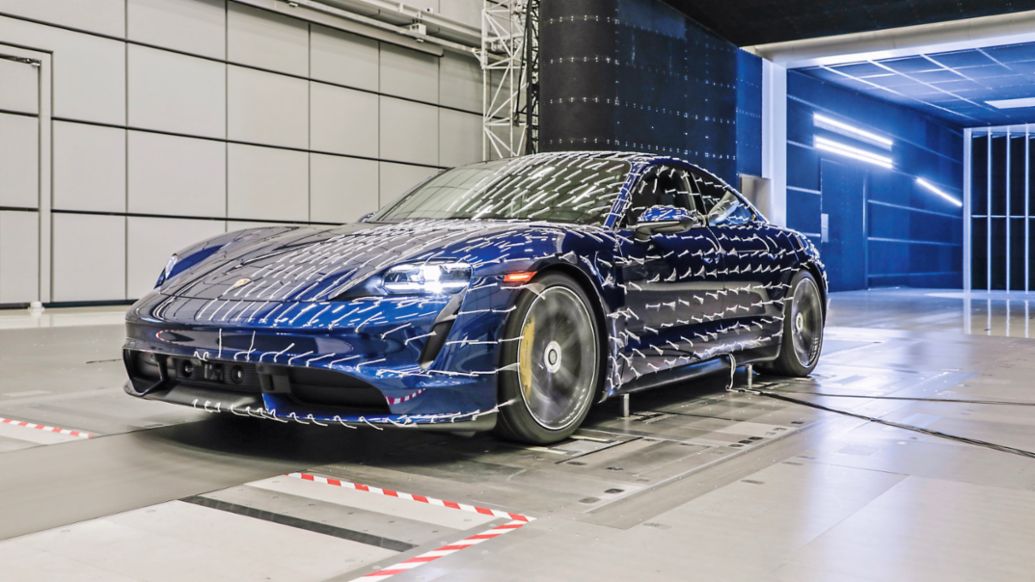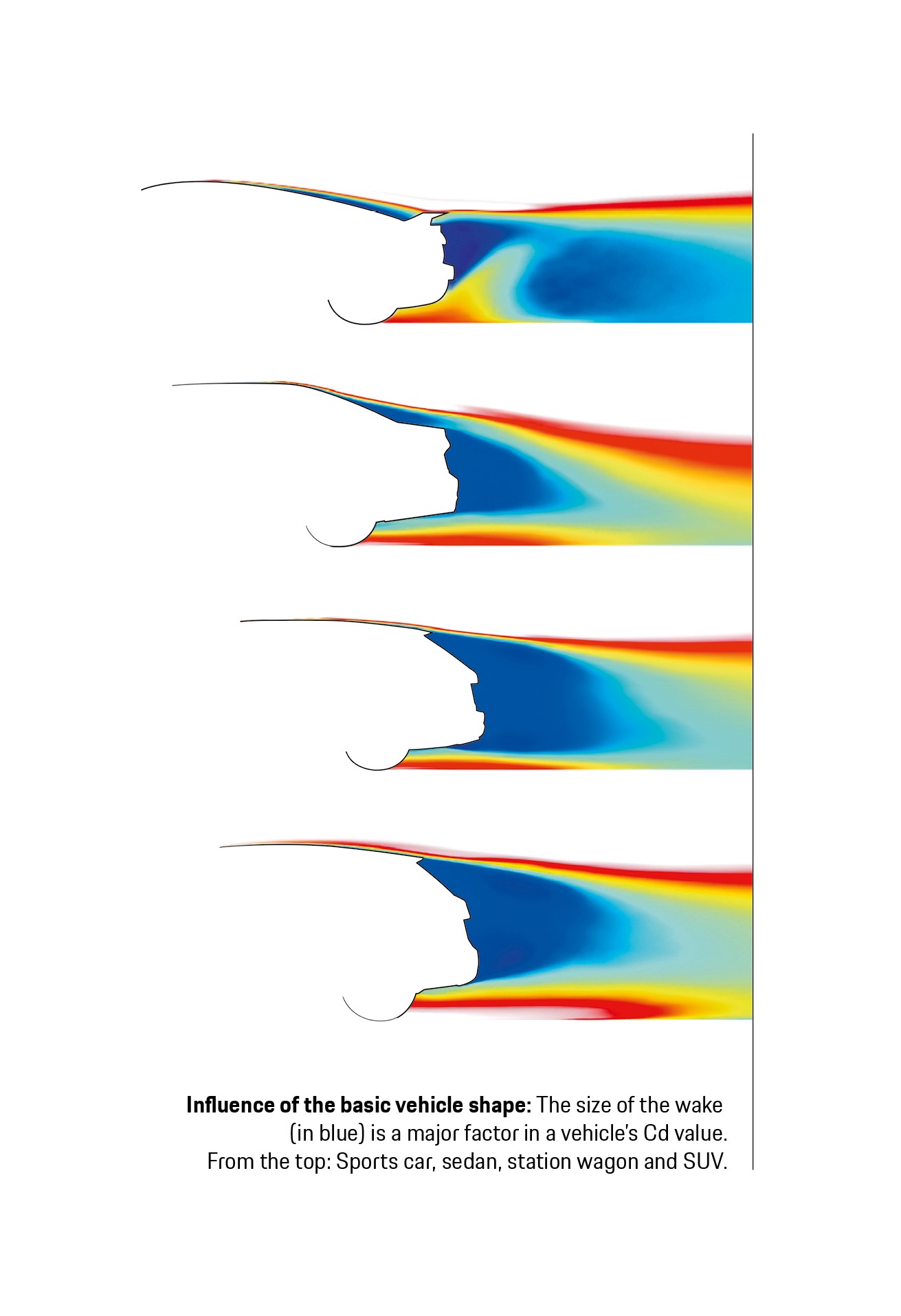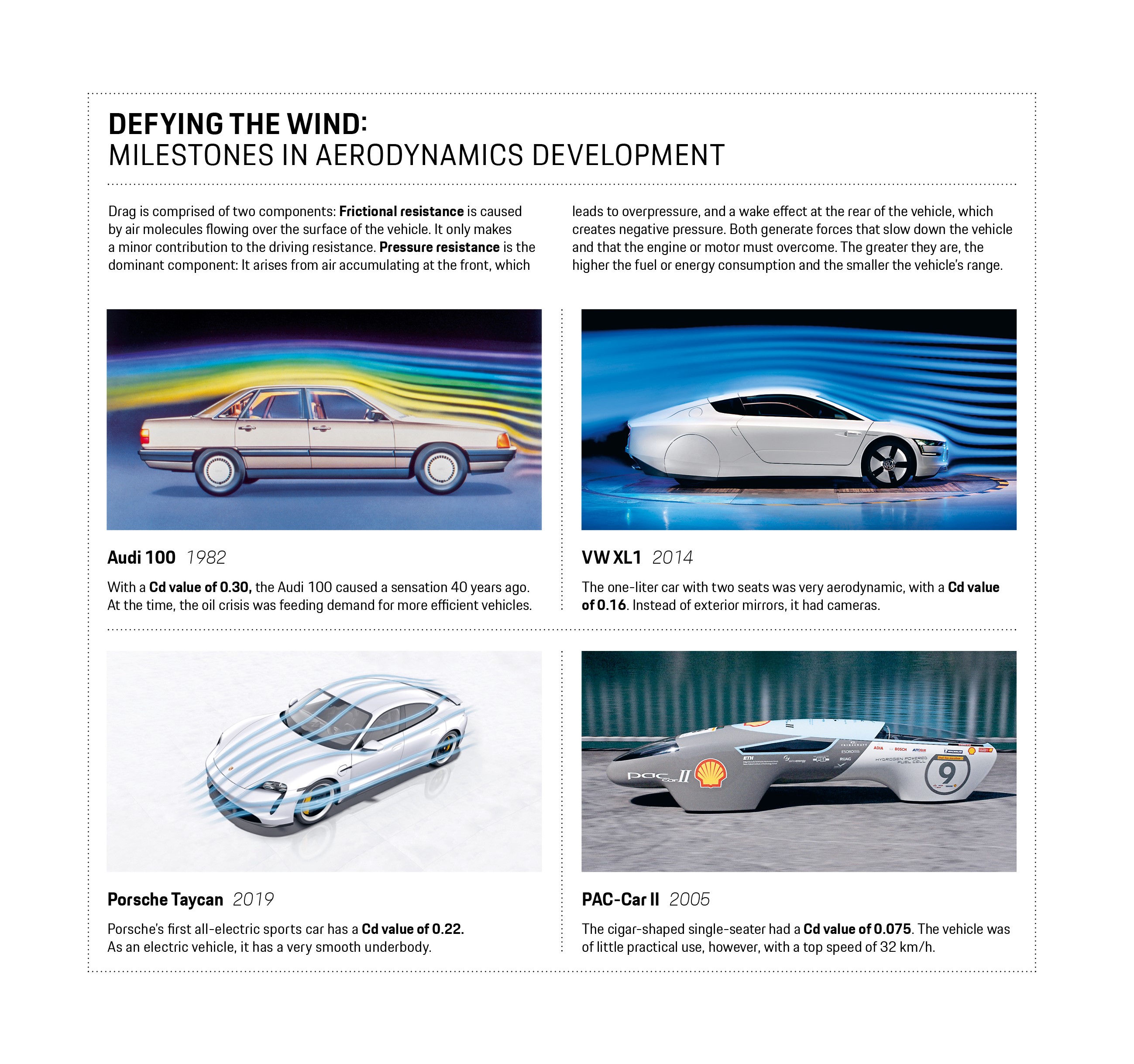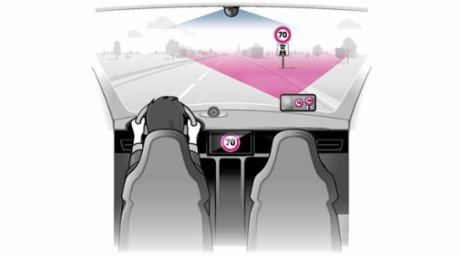Forty years ago, many car drivers learned a new term: Cd value. When the new Audi 100 was launched in 1982, the manufacturer presented it as ‘the most streamlined production sedan in the world’. Its Cd value of 0.30, impressive by the standards of the time, was proof positive. The fact that the aerodynamic drag of vehicles had suddenly become a selling point was due to the oil crises of 1973 and 1979, which had occurred just a few years prior. Fuel prices had risen sharply since then, and the efficiency of vehicles was increasingly becoming a focus of interest.
This also increased the importance of aerodynamics. Aerodynamic drag plays an important role in fuel consumption, especially at higher speeds (see the box on page 32). “At roughly 80 km/h or more, it becomes more important than the rolling resistance of the tires,” explains Marcel Straub, Lead Engineer Aerodynamics and Thermal Management at Porsche Engineering. “And because it increases quadratically with speed, aerodynamics is quite decisive for fuel consumption, particularly when driving on the highway.”
A vehicle’s aerodynamic drag is determined by the product of its frontal area and Cd value. The latter indicates how streamlined a geometric shape is. There’s a simple rule of thumb: the smaller, the better. Drops of water come pretty close to the ideal because they are round at the front and have a long taper at the back. Their Cd value is a mere 0.05 (see the text on page 34). The problem, however, is that it is difficult to fit the powertrain, passengers and the payload into a drop-shaped vehicle.
Since the 1980s, the typical wedge shape with a rounded front and angular rear has come to prevail. Its main purpose is to minimize the wake behind the vehicle. Sharp edges allow the flow to separate in the manner intended and reduce negative pressure, which in turn reduces drag. Cd values were getting better all the time: The Opel Calibra came in at 0.26 in 1990, and ten years later the Audi A2 boasted a value of 0.25. “Those were real leaps ahead in aerodynamics,” recalls Prof. Andreas Wagner, Chair of Automotive Engineering at the University of Stuttgart.
The next leap is currently underway, driven by the transition to electromobility. “Electric powertrains have much higher efficiency than internal combustion engines, so other energy consumption factors become much more significant,” explains Dr. Thomas Wiegand, Manager Aerodynamics - Research & Development at Porsche AG at Porsche AG. “In the WLTP driving cycle, aerodynamics account for 30 to 40 percent of the losses in electric cars, as opposed to less than ten percent in a vehicle with a diesel or gasoline engine. And because the average speed in realistic cycles is even higher than in the WLTP, this figure is likely to be even higher than 50 percent when electric vehicles are driven in realworld situations.”
Manufacturers are, accordingly, placing great emphasis on optimizing the aerodynamics of their e-vehicles. The new drive technology is helping them to do so: Vehicles with combustion engines have a center tunnel in the underbody and an exhaust system that has to be cooled by ambient air. This irregular surface generates turbulence and increases driving resistance. In electric cars, on the other hand, the battery is found between the front and rear axles. Its underside is completely smooth, which promotes good aerodynamics.
Active aerodynamics
Another advantage of e-mobility is that the motors generate less heat, which means that less energy has to be dissipated using the radiator. As a result, less or even no airflow is needed through the engine compartment, in turn reducing the aerodynamic drag of e-vehicles. In many e-vehicles, cooling air shutters for individual activation in the air intakes ensure that only the volume of air actually needed is directed over the radiators and brake discs. Because the technology actively intervenes according to the driving situation, experts refer to measures like these as ‘active aerodynamics’.
This also includes retractable spoilers and air-spring suspension chassis that lower the car at high speeds. “To implement these measures, at Porsche Engineering we build up on our expertise in function and software development,” says Straub. “This allows us to bring the active measures on the functional side safely to production readiness.” Modern e-vehicles make use of many of these technical capabilities: With Cd values of 0.22 and 0.20, the Porsche Taycan and Mercedes EQS respectively are miles ahead in terms of aerodynamics.
Active aerodynamics measures could play an even greater role in the future and significantly change the appearance of vehicles while driving. Mercedes-Benz, for example, has presented the Vision EQXX concept car with a Cd value of 0.17. One of the visible changes while driving is the diffuser on the lower edge of the rear: It automatically extends rearward by 20 centimeters at speeds above 60 km/h. Together with the sharp separation edge on the unusually long rear end, it ensures minimal drag.
“With the EQXX, the focus was on energy efficiency,” says Dr. Stefan Kröber, aerodynamics engineer at Mercedes-Benz and lecturer at the Karlsruhe Institute of Technology. “Optimized aerodynamics are an important element of that. The EQXX is expected to consume less than 10 kWh per 100 km, while the current EQS still comes in at 15 kWh or more.” Expert Straub can also imagine that cars will change shape while driving in the future: “The rear end could, for example, become more angular at high speeds to form sharper separation edges. New shape-memory materials could provide the basis for this. They change their geometry according to temperature or applied voltage.”
At the University of Stuttgart, researchers are pursuing an entirely novel approach: “We are examining whether it is possible to reduce the Cd value at certain points in the car body by systematically introducing vibrations,” Wagner explains. “If you introduce a defined pulse into the flow around the car using speakers, its separation behavior can be influenced.” In the case of an SUV, he says, it was possible to reduce the Cd value by seven percent using this method. “But that still has some way to go before series production,” Wagner said. “We have to make sure, for example, that passengers don’t hear any buzzing or humming.”
Better and better simulations
Engineers and designers assess how much their ideas affect the aerodynamics of new vehicles in the wind tunnel and by using CFD simulations (computational fluid dynamics). “CFD simulations have become enormously important in the last 20 years,” Wagner says. “People have better understood the mathematical methods, developed more accurate tools, and also increased the processing power of the computers.”
Today, however, computer simulations still encounter limitations. For example, it is currently only possible to calculate the effects of the rotating tires to a limited extent. Nor can their deformation under the weight of the vehicle be simulated with sufficient accuracy today. In the future, this should become possible, as should computer-aided optimization of the vehicle geometry. “Numerous parameters play a role here, such as the progression of the side profile, the A-pillar, the rear lid height and the diffuser angle,” Wagner explains. “This results in so many possible combinations that a human being can no longer keep track of them.” Intelligent algorithms, on the other hand, could move through the mass of variants and specifically find those combinations that promise a low Cd value. It would then also be possible to keep one parameter—such as the height of the rear lid—constant for design reasons and, taking this boundary condition into account, run through the remaining geometric variants.

. In the future, artificial intelligence (AI) is expected to contribute to more efficient processes. “At the end of development, we are obliged to specify individual consumption or range values for each vehicle variant, in which weight and rolling resistance play a role in addition to the aerodynamics,” says Wiegand. “We therefore have to generate large volumes of data for the aerodynamics component.” At the same time, a large number of measurements from the wind tunnel and simulation results are already available from the previous development phases. This data will be better structured in the future, and be analyzed using modern methods. “AI algorithms could generate new data from a stock of existing data through interpolation and extrapolation. This would allow us to plan specific experiments and reduce their number. And we would no longer need to measure all variants for classification.”
Real-time optimisation with AI
Porsche Engineering is also working on using AI methods. The developers’ goal is to predict the effects of changes to the vehicle geometry in real time. While a time-consuming CFD simulation is still required for each variant today, in the future a neural network will calculate the influence on the Cd value much faster. “You change a shape with the mouse and immediately see what that means for the aerodynamics,” says Straub. “We have already used this AI-based method for the wing profile of a Porsche GT3.” Development of the new approach is continuing in collaboration with the AI experts at Porsche Engineering and the method development team at Porsche AG in Weissach.
Even so, there’s no reason to expect that all aerodynamically optimized vehicles will look the same in the future. “A good Cd value can be achieved in different ways,” says Wagner. “If you want to optimize the rear end, for example, you can change the rear lid height and the diffuser in the underbody. You then have to work with the design team to arrive at an ideal solution that fits the brand. This allows comparable aerodynamics to be achieved with different shapes.” Straub also downplays the notion that there will be a uniform design across the board in the future: “There will be no risk of mistaking one car for another—even for the best vehicles in terms of aerodynamics.”
Summary
With the transition to e-mobility, vehicle aerodynamics are currently taking a big leap forward. In the future, active measures such as modifiable shapes in the rear or vibrations that are introduced systematically will increasingly come into play. Great progress is also being made in simulations and test optimization using artificial intelligence.
Info
Text first published in the Porsche Engineering Magazine, issue 2/2022.
Author: Christian Buck
Copyright: All images, videos and audio files published in this article are subject to copyright. Reproduction or repetition in whole or in part is not permitted without the written consent of Dr. Ing. h.c. F. Porsche AG. Please contact newsroom@porsche.com for further information.







